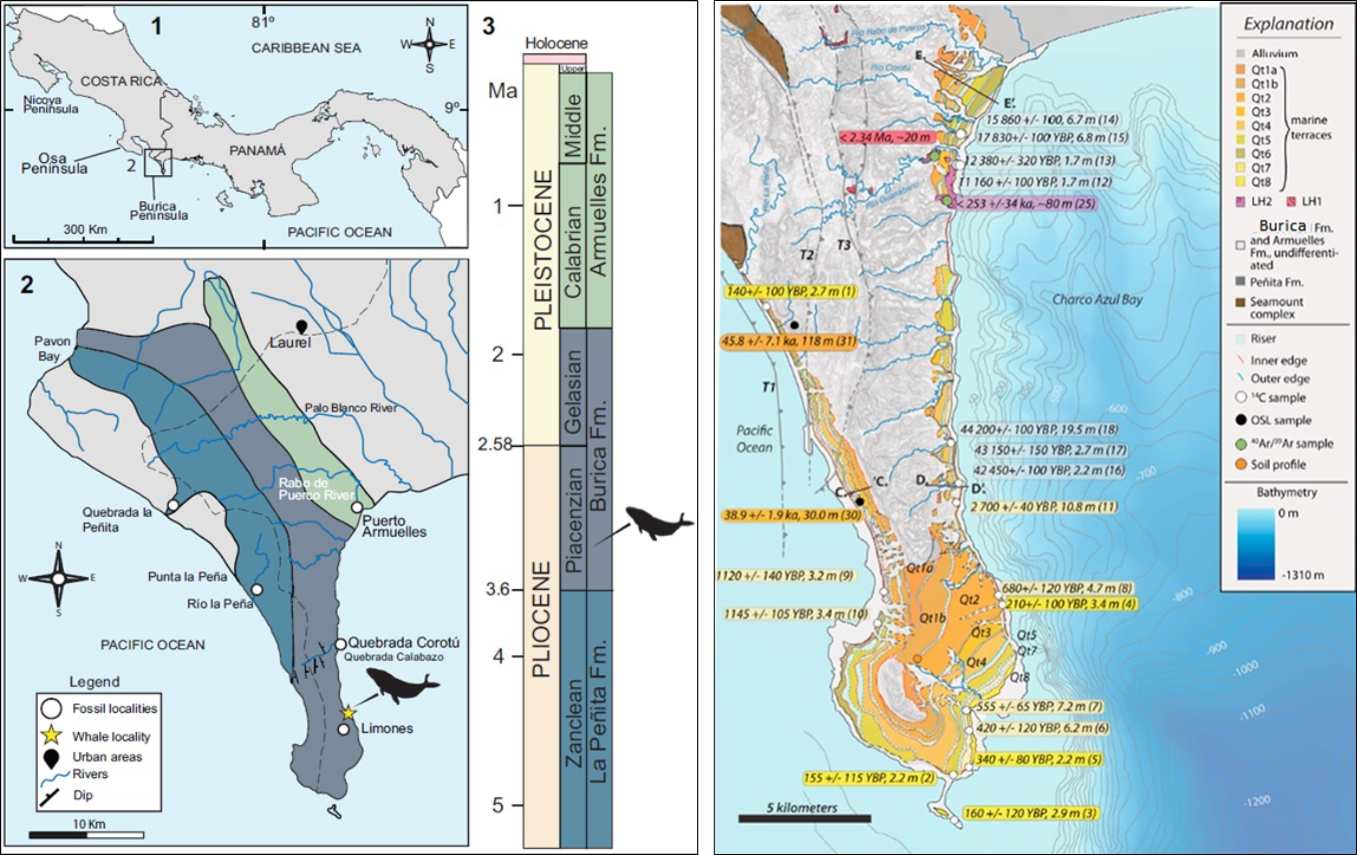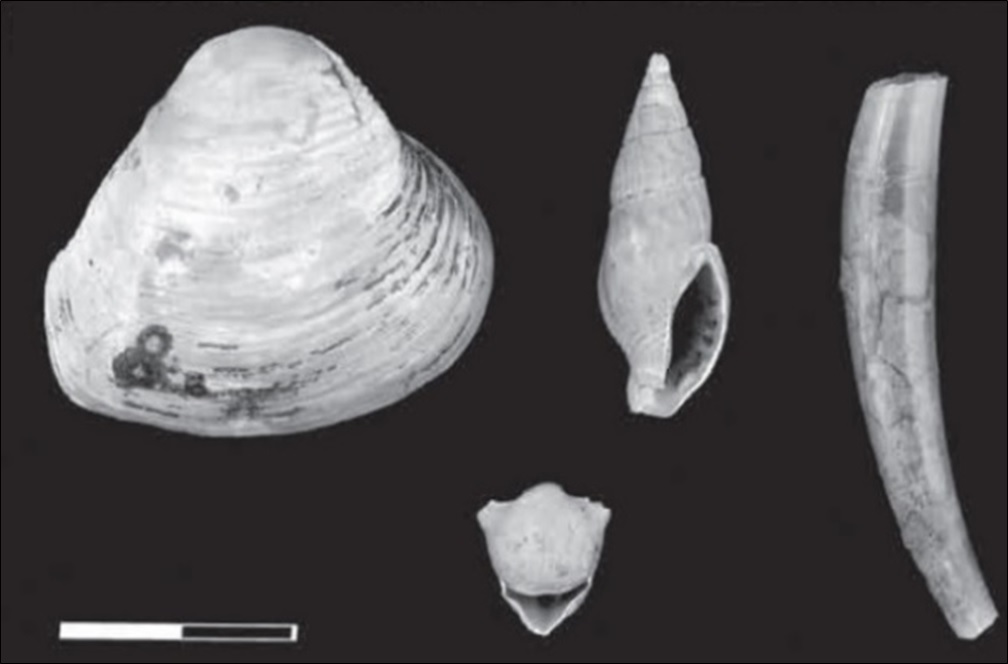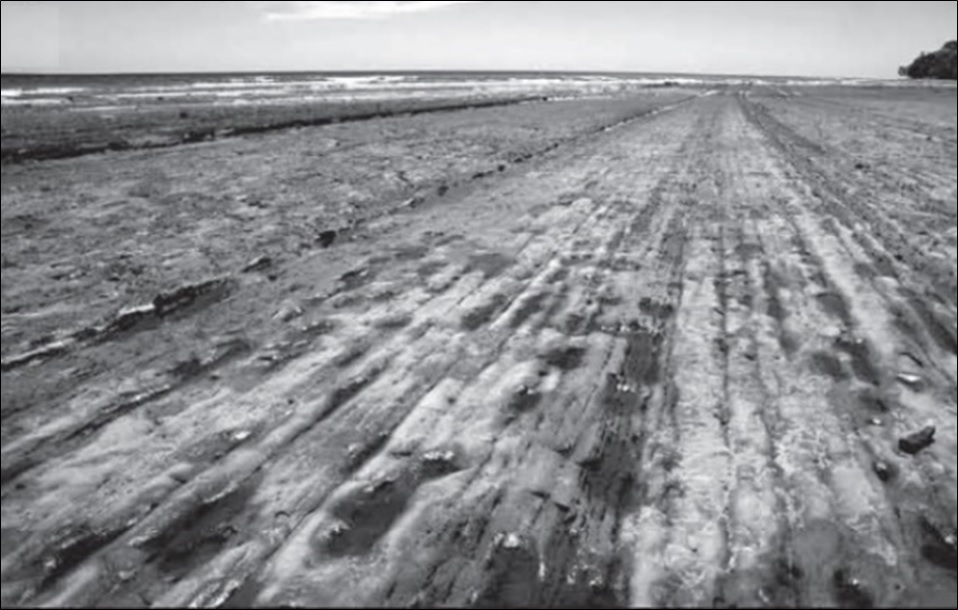Burica Fm
Type Locality and Naming
Type Locality is at Burica Peninsula (Figure 046) at or near Burica Point and Burica Island.
Synonym: Burica Member; Burica sandstones; See “Charco Azul Gr” for some additional comments on synonymy.
Lithology and Thickness
The Burica Fm represents the extraordinary sum of 2,800m of deposits dominated by volcaniclastic turbidites (Figure 060, left). A turbidite is a group of sediments originating from the coast and the shelf, but which have been precipitated by the steep slope of the marine shelf and have been redeposited in deep seas (Coates et al. (1992)). As a result of this, the fossils that occur in the Burica Fm are usually a combination of species from shallow seas. For example, the mollusk fauna is dominated by the Nuculidae (Figure 060, right) and Tellinidae families, shallow-water bivalves, as well as the gastropods Columbellidae, Calyptraeidae and Nassariidae, but it is also possible to find very deep indicator fossils such as the planktonic gastropod Cavolinia (Cavoliniidae) (Figure 060, right), and the deep-sea scaphoid Cadulus (Emerson (1957)) (Figure 060, right), and certain benthic foraminifera showing that the lowest part of the Burica Fm was deposited at a depth of about 2,000m (Collins et al. (1995)). The Burica Fm is best exposed in an impressive 20km section on the east side of the Burica Peninsula (Figure 060, left), although the small number of horizons rich in mollusks can make it difficult to collect fossils through this succession.
Coates et al. (1992), O'Dea et al. (2012) and De Gracia (2015) subdivide the formation into two members without elaborating on their respective fabric, while Buchs (2008) and Buchs et al. (2009) only briefly describe the Chancha Member. See Charco Azul Gr
Thickness: 2800 m according to Coates et al. (1992).
Relationships and Distribution
Lower contact
Upper contact
Regional extent
GeoJSON
Fossils
[Figure 060. The Burica Fm (to) and some representative fossils (bottom). A succession of 20 kms of turbidite deposits exposed at low tide along the eastern coast of the Burica Peninsula (left). The Burica Fm has a mixture of shallow water taxa which include Nuculidae (top left) and Columbellidae (centre) as well as deep water taxa such as the rare planktonic gastropod Cavolinia (bottom) and the Lidophile scaphopod Cadulus (right). Scale = 1cm. O'Dea et al. (2007).]
Age
Depositional setting
Additional Information
References:
- Olsson (1942a). Sandstone transitional with overlying Charco Azul shales. Base of sand stones and basement on which they rest not exposed. Age tentatively considered as lower Pliocene or uppermost Miocene.
- Olsson (1942b). Lower part sandstones and conglomerate; upper part tuffaceous shale. The “Burica Sandstone” is defined as the oldest formation cropping out on the Burica Peninsula at and near Burica Point and Burica Island. The formation is made up of sandstone, which gradationally underlies finer grained rocks of the Pliocene Charco Azul Fm. The base is not exposed, and the exposed thickness was not specified. The mollusks include Phos gatunensis, Turritella cf. gatunensis, Solemya burica, and Thyasira bisecta.
- Coryell et al. (1942); Wilson et al. (1957);
- Woodring (1960); Obando (1986)
- Corrigan et al. (1990), originally named the “Charco Azul Gr” as the “Charco Azul Fm” and included in it its three Members “Peñita”, “Burica” and “Armuelles”. It is only later that it was renamed as a Group, while each of its members were given the designation of “Formation”.
- Coates et al. (1992); Kolarsky (1992); Collins et al. (1995) ; Kolarsky et al. (1995a, 1995b) ; Schlegel (1996); Leon-Rodríguez (2007) ; O'Dea et al. (2007); Buchs (2008); Buchs et al. (2009); Morell et al. (2011) ; O'Dea et al. (2012); De Gracia (2015) ; Cortés et al. (2019) ; Timmons (2019) ;


